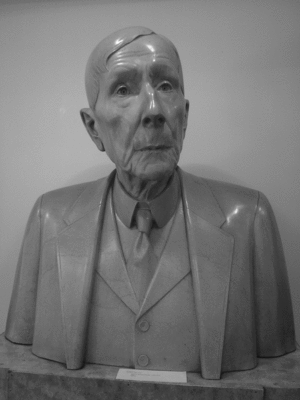by Christina Pyrgaki
Entering the Rockefeller Research Building (RRB) lobby there is no escaping the vigilant eyes of the sculpted and painted portraits arranged in a row along both of its side walls. And when you leave RRB late in the evening, after a long day in the lab, tired, with your attention divided between the experiments done and the experiments that still need doing, exiting the elevator and walking towards the doors can be an eerie experience. John D. Rockefeller’s marble bust, created by Jo Davidson, stands out as the most impressive amongst those in this collection.
Jo Davidson (1885-1952), who was primarily a portraitist, became an academic portrait sculptor in marble, bronze, and terra cotta and sculpted portraits of many of the world’s famous personalities. He did not have his subjects pose; rather, it is said that he was an outgoing personality who preferred to observe and speak with them, to get to know them as people. A remarkably clear-sighted and observant portraitist, Davidson could evoke the essence of the sitter’s character. Thus, there was no flattery in any of the portraits he created; what you see is essentially who the subject is, or rather was, not just what he looked liked, nor what he wished to look like, nor what he wished to be for that matter. “That’s Gertrude Stein, that’s all of Gertrude Stein, that’s all of Gertrude Stein there is,” Stein once remarked, referring to her massive bronze likeness sculpted by Jo Davidson.
Can we safely conclude then that what we see of John D. Rockefeller through this haunting bust is who he actually was? The bust depicts a distant, quiet man for whom ideas seemed to be constantly brewing in his mind. His slightly turned head, upward look, and barely raised hairless skin where his eyebrows once were (he lost all his hair due to stress-induced alopecia at the age of 52) suggest indifference, if not disdain, for all that is going on around him. He is looking up and forward, which could be a metaphor for his attitude throughout his entire life. His mouth is held in a straight line, with a slight downward bent at the corners. It is almost impossible to imagine this mouth forming a smile. It makes him look strict, serious, somber, as was his upbringing by his austere Baptist mother, but also, surprisingly for a man of his status and wealth, cheerless. The lips, which he held so tightly sealed throughout his entire life (“Success comes from keeping the ears open and the mouth closed,” he used to say) are the most poignant feature of his face.
You can tell that this is the bust of a man who was “all-business,” which, I guess, is the only way a man who started a company at the age of 19 and grew to become the wealthiest man in history could be. But, even though the bust perfectly portrays the industrialist in his all-business, aloof persona, it does not make it at all easy to see the philanthropist, the man who from his first employment as a clerk at the young age of sixteen sought to give away one-tenth of his earnings to charity.
John D. Rockefeller’s donations grew with his fortune and the total of his lifetime philanthropic work has been estimated at about $550 million. He founded the University of Chicago (1892), and The Rockefeller University—formerly Rockefeller Institute for Medical Research—in 1901. He also founded the General Education Board in 1903 and established the Rockefeller Sanitary Commission, which was largely responsible for eradicating hookworm in the South by 1927. His fortune reached $900 million by 1912 despite his already having given away hundreds of millions of dollars. When he died, on May 23, 1937 his estate totaled $26,410,837. He had given most of his property to his philanthropies, to his son, and to other heirs. The eradication of hookworm in the South alone would merit his place as one of the great humanitarians of the twentieth century, but his reputation was so sullied that he never received the credit he was due for this great act on behalf of humankind.
I would be tempted to think that his sullied reputation was also the reason that the marble bust does not exhibit any of the kindness that one would assume characterizes a philanthropist of Rockefeller’s magnitude. It is unlikely, however, that Davidson would allow such bias to interfere with what he saw, as he got to know his subject. Could it be that Rockefeller’s humanitarian action was not the result of kindness, but that of duty? He, himself, stated: “Every right implies a responsibility; every opportunity, an obligation; every possession, a duty.” He had many possessions, so his duty was, again in his own words to “…make money and still more money and to use the money I make for the good of my fellow man according to the dictates of my conscience.” Is this the reason that the exquisite bust that Davidson created depicts a strict, stern old businessman and not a humanitarian? Maybe, but that is not really important. What really matters is that Davidson, in all his artistic genius, captured the quintessence of the astute industrialist and immortalized him in marble, so that he can solemnly observe the scientists of the institute he funded while they serve science “pro bono humanis generis,” as John D. Rockefeller, the humanitarian, intended it!
References:
- Jo Davidson, Between Sittings (New York, NY: Dial Press, 1951)
- Chernow, Ron. Titan: The Life of John D. Rockefeller, Sr. New York: Random House, 1998.
- http://www.brainyquote.com/quotes/authors/j/john_d_rockefeller.html#St41M5DkQ1t2dUys.99
July/August 2012

